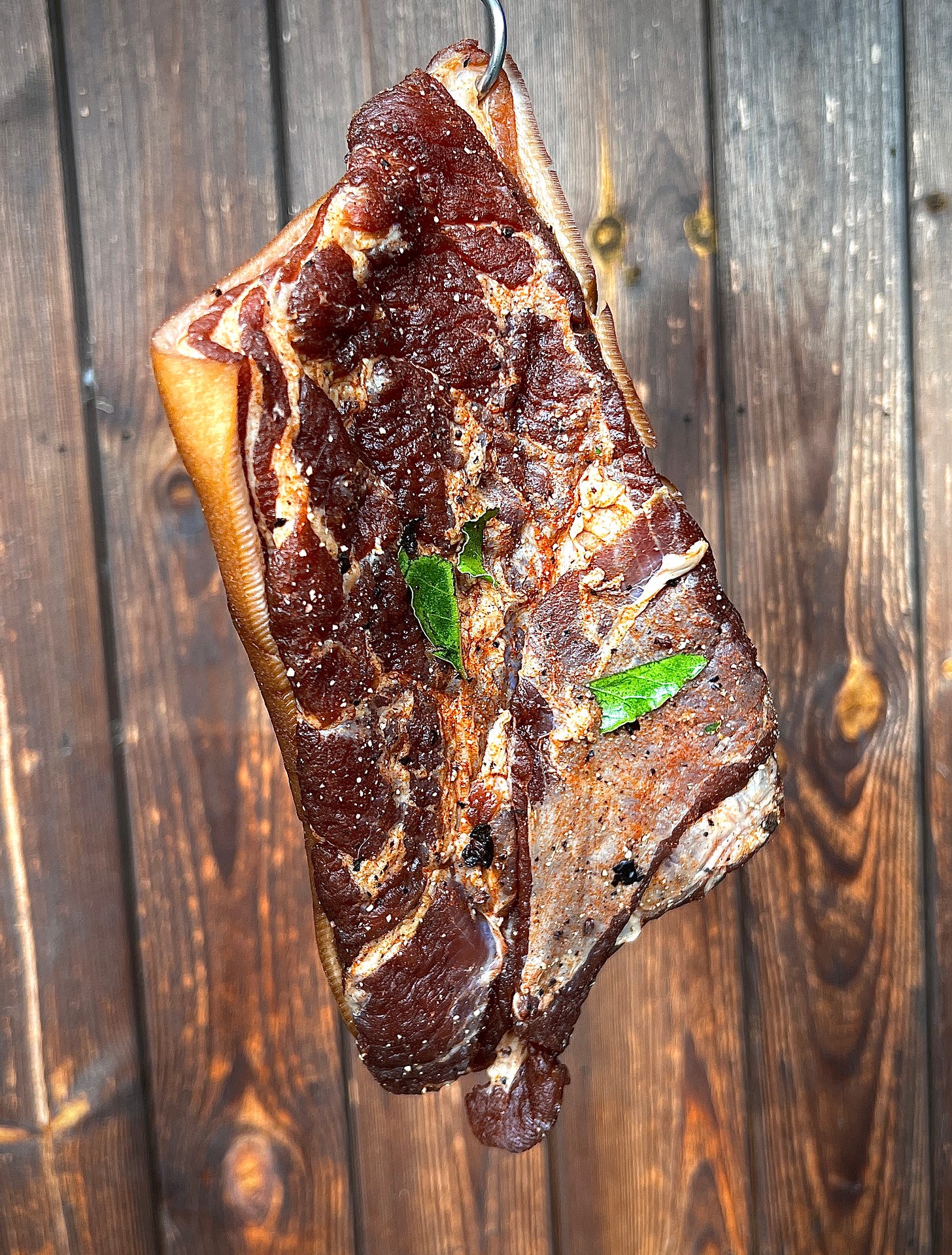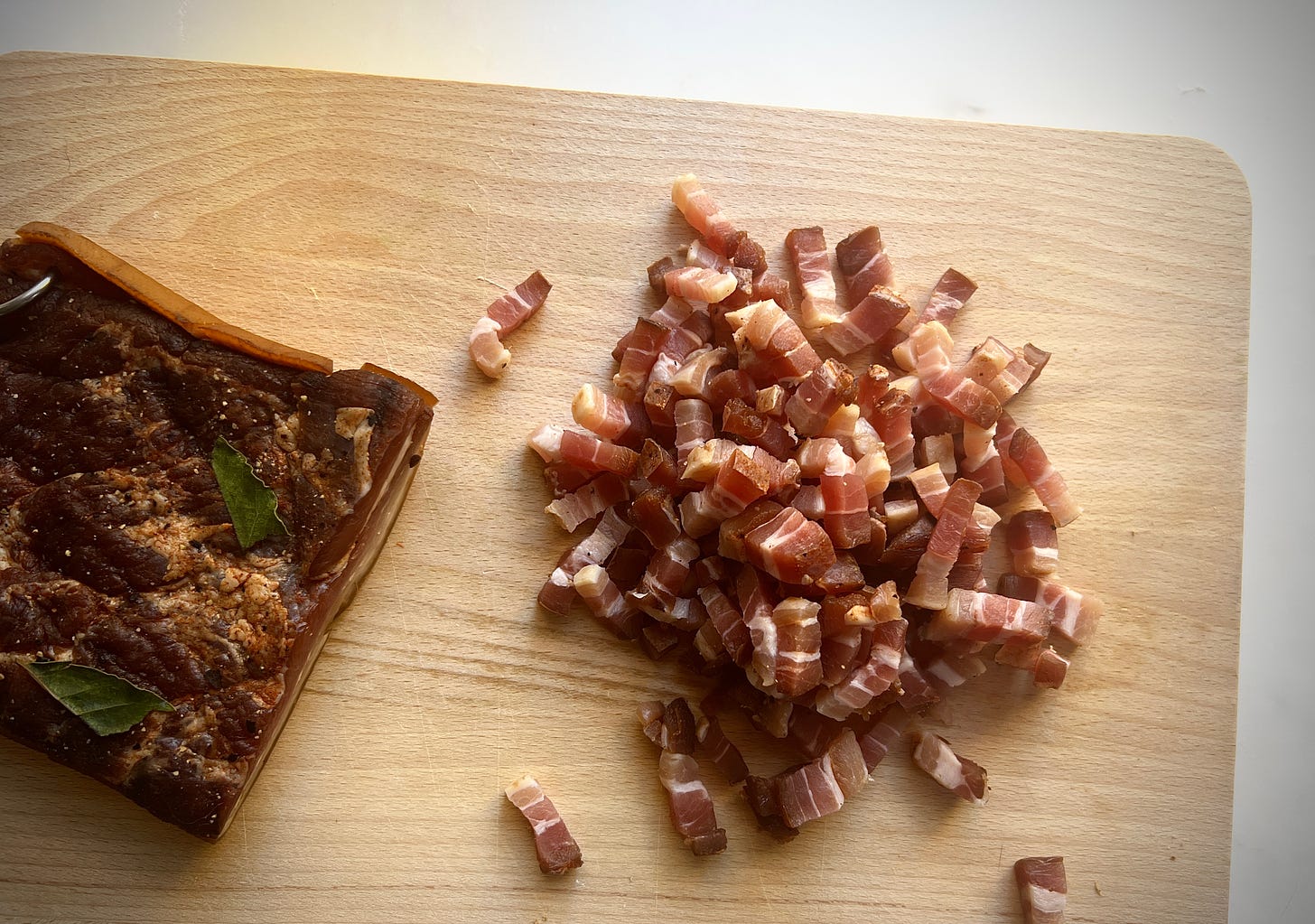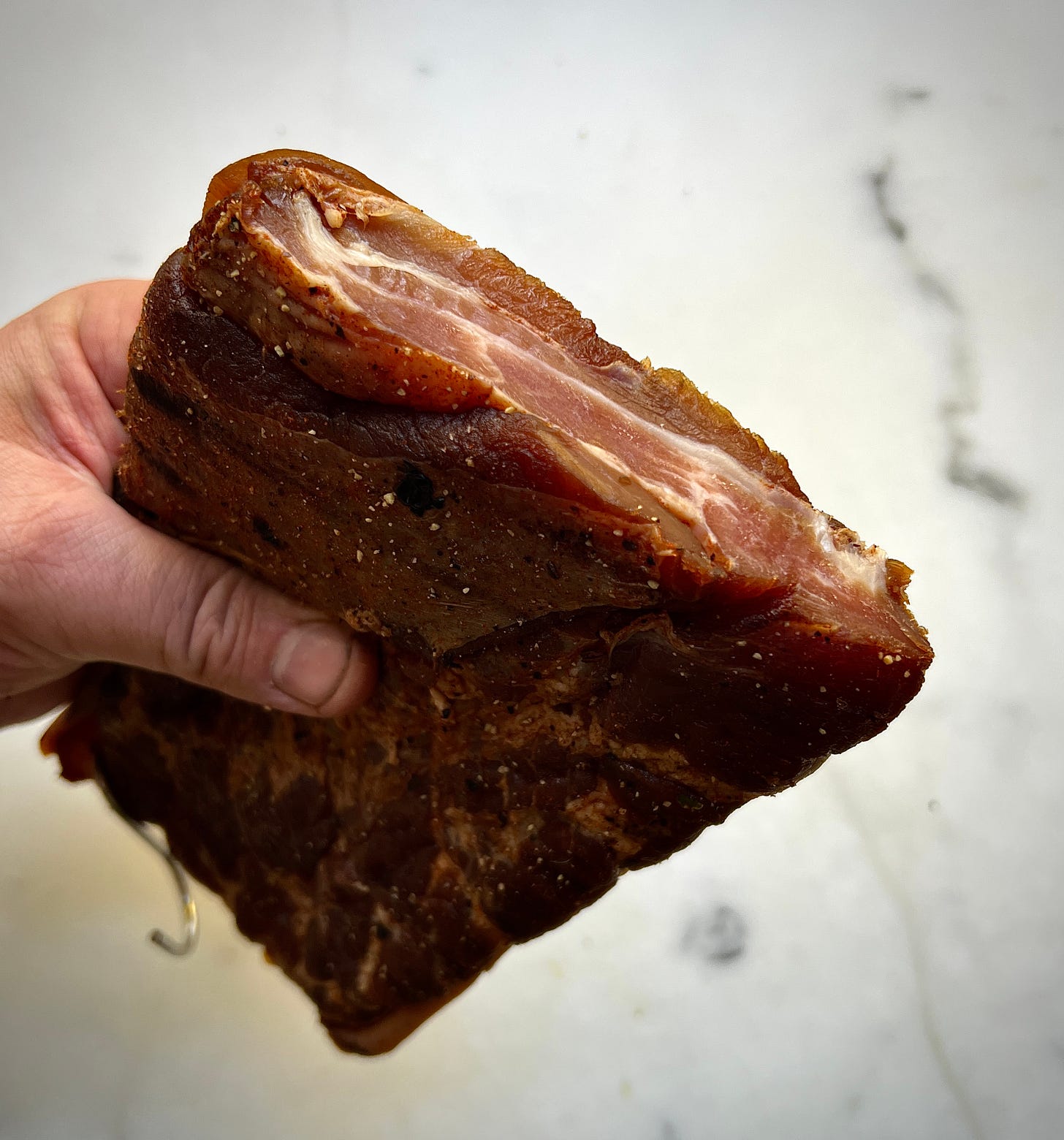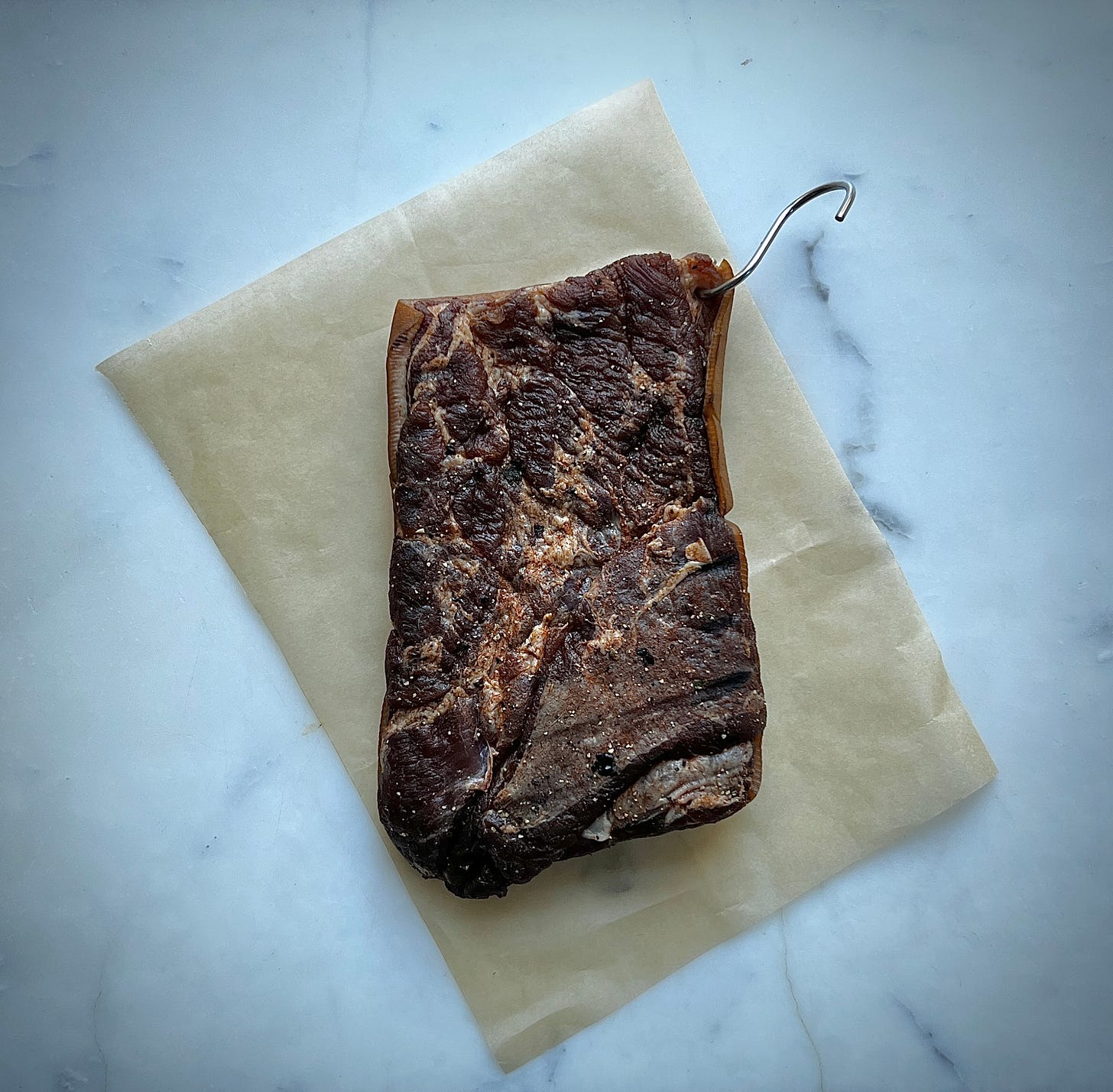The smell is quite unreal after smoking. Far away from anything that you might buy in a shop.
The smell and flavour of the applewood is well pronounced, warm and familiar. I left the rind on my piece as I use it often in my cookery, letting it twist and render in hot sizzling fat, to begin the layers of flavour in a pan. It would be a waste to cut it off.
I unhook the dark slab of pork from the rack in the fridge, place it on my chopping board and cut one thick slice about the width of my little finger.
Cutting along into lardons, I then place a pan on the fire, adding just a spoonful of oil. The piece feels dry, it has lost moisture, though I didn’t weigh it. As this chunk of streaky is for cooking, I didn’t feel the need to keep a record of its weight, unlike when making pancetta where the weight loss from the slow airdrying is an indication of whether the piece is ready or not, but that is for another day. This is firm and aromatic with the smell of spice. The muscovado and oily smoke have stained the meat a dark shade of brown. The smell gives me an indication that this will be delicious.
I add the lardons to the pan, letting them sizzle in the fat. The smell of bacon fills the kitchen. To those who thought to tell me that this would be difficult to cook as the sugar would cause it to burn, then I’ll say that you should have no worries here, though if you’re unable to cook bacon without controlling the heat properly in the first place then yes it might burn,
Mine doesn’t, nor should yours.
It is delicious.
Crisp, fatty lardons, enriched with treacle, salt and woodsmoke. Sweet cured and spiced with warm black pepper. I cut off another chunk in preparation for lunch, again cutting it into a pile of small neat lardons. I have pears that would roast perfectly for a salad.
And walnuts.
How to smoke your bacon
As I left you last week, your bacon is ready to be taken from its sticky brown brine after six days. The magic from the salt and the sugar has worked. It has changed a soft piece of belly pork into a firm, dark piece of meat. The nitrite salt, even in the minimal quantity that we used, has kept the bacon pink and has prevented the nasties from gaining a foothold.
The bacon must be rinsed thoroughly of its cure, then dried well with paper, working into any seams so that the piece is firm and dry.
Now take a metal hook and push it through one end. If you now hang the piece in a fridge for forty-eight hours then all is well. A pellicle will form as it hangs in the fridge, a dry crust if you like, that will allow the smoke to adhere to the bacon as it smokes. This is part of airdrying. Do not be tempted to skip this step. You must be patient.
You will need wood chips, let us say a large bowl full. Applewood is ideal, as well as hickory or cherry. Oak at a push if you can’t find the others. You will need a barbecue with a vent or two that you can control the airflow through.
Light a small fire with kindling, just a handful of sticks, letting them burn out to a glowing smoulder. The embers will slowly ignite the wood chips, so now carefully add a handful over the fading fire. You could blow gently at the heart of the coals, watching to see the smoke build. This must not be a hot fire of any sort. The temperature should not register on the gauge of the barbecue. When the chips are smoking, don’t smother the fire with too much woodchip, as it will choke it. The smoke needs to build up in strength. Coax the woodchip to a smouldering pile, adding more until the small heap has settled into a slow burn. Keep the vents open to encourage airflow through the unit, keeping the embers lit well enough to keep the temperature low, but letting the smoke build.
If you use a Green Egg as I do, set up the ceramic plate over the cinders and smouldering woodchip, then place the rack on top. The pork can be laid onto the bars of the rack, or you could hang it on its hook inside the chimney. by using a couple of long metal skewers.
Either way works well.
The lid should now be closed to allow the smoke to build in the sealed chamber, remembering to control the vents to prevent the temperature from rising, keeping the smoke building steadily like a bonfire on a damp Sunday afternoon, swirling like a thick mist, that stings your eyes if you get too close. This is cold smoking so the fire must not be allowed to ignite into flames. The smoke from the chips should rise from the chimney in a continuous cool plume. The meat when placed inside will be bathed in the cool grey vapour. The opposite of this method is hot smoking, which would certainly work, but not for today.
Let’s keep that for another day.
When the smoke has built, add the bacon to the chamber, and close the lid, setting the vents to minimal. You will need to check every half an hour or so to ensure that the smoke is still puffing away. You don’t need to open it, just look at the chimney or top vent to see that the smoke is gently whirling away.
I smoked my piece for three hours. I didn’t open the lid. Patience is key with tasks like this. There is no quick fix. Try not to fiddle, just let the process happen.
When three hours have passed, open up and remove the piece of bacon from the chamber and admire your work, then hang it somewhere cool to allow it to rest. The smell will be divine. It will be strong though so you could put it into a sealed bag, so as to prevent your whole fridge from smelling like a smokehouse.
In my opinion, I think it is better to let anything that has been freshly smoked, rest for a day before checking. The volatile compounds will soften and become less acrid after a day or so.
When you are able to wait no more, then take your piece, admire it once again, cut a thick slice and test it for yourself, sizzling it in a pan.
You will never have tasted anything quite so delicious.
And you will have made it yourself.
Until Sunday
William








Something that just occurred to me you might want to experiment with is flagrantly ( fragrantly 🤭) stolen from Cantonese cured bacon or lap yuk.
You add a slice or two cut into lardons or just add whole to your rice in the rice cooker and then cook as normal.
Will, your reverence for what you cook is one of your greatest charms.